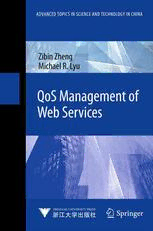Table Of ContentAdvAnced Topics in science And Technology in chinA
Zibin Zheng
Michael R. lyu
Qos Management of
Web services
123
ADVANCED TOPICS
IN SCIENCE AND TECHNOLOGY IN CHINA
ADVANCED TOPICS
IN SCIENCE AND TECHNOLOGY IN CHINA
ZhejiangUniversityisoneoftheleadinguniversitiesinChina.InAdvancedTopics
inScienceandTechnologyinChina,ZhejiangUniversityPressandSpringerjointly
publishmonographsbyChinesescholarsandprofessors,aswellasinvitedauthors
and editors from abroad who are outstanding experts and scholars in their fields.
Thisserieswillbeofinteresttoresearchers,lecturers,andgraduatestudentsalike.
AdvancedTopicsinScienceandTechnologyinChinaaimstopresentthelatestand
mostcutting-edgetheories,techniques,andmethodologiesinvariousresearchareas
in China. It covers all disciplines in the fields of natural science and technology,
including but not limited to, computer science, materials science, life sciences,
engineering,environmentalsciences,mathematics,andphysics.
Forfurthervolumes:
http://www.springer.com/series/7887
Zibin Zheng • Michael R. Lyu
QoS Management of Web
Services
With 42 Figures
123
ZibinZheng MichaelR.Lyu
TheChineseUniversityofHongKong TheChineseUniversityofHongKong
HongKong HongKong
People’sRepublicofChina People’sRepublicofChina
ISSN1995-6819 ISSN1995-6827(electronic)
ISBN978-3-642-34206-6 ISBN978-3-642-34207-3(eBook)
DOI10.1007/978-3-642-34207-3
SpringerHeidelbergNewYorkDordrechtLondon
LibraryofCongressControlNumber:2013930360
©ZhejiangUniversityPress,HangzhouandSpringer-VerlagBerlinHeidelberg2013
Thisworkissubjecttocopyright.AllrightsarereservedbythePublisher,whetherthewholeorpartof
thematerialisconcerned,specificallytherightsoftranslation,reprinting,reuseofillustrations,recitation,
broadcasting,reproductiononmicrofilmsorinanyotherphysicalway,andtransmissionorinformation
storageandretrieval,electronicadaptation,computersoftware,orbysimilarordissimilarmethodology
nowknownorhereafterdeveloped.Exemptedfromthislegalreservationarebriefexcerptsinconnection
with reviews or scholarly analysis or material supplied specifically for the purpose of being entered
and executed on a computer system, for exclusive use by the purchaser of the work. Duplication of
this publication or parts thereof is permitted only under the provisions of the Copyright Law of the
Publisher’slocation,initscurrentversion,andpermissionforusemustalwaysbeobtainedfromSpringer.
PermissionsforusemaybeobtainedthroughRightsLinkattheCopyrightClearanceCenter.Violations
areliabletoprosecutionundertherespectiveCopyrightLaw.
Theuseofgeneraldescriptivenames,registerednames,trademarks,servicemarks,etc.inthispublication
doesnotimply,evenintheabsenceofaspecificstatement,thatsuchnamesareexemptfromtherelevant
protectivelawsandregulationsandthereforefreeforgeneraluse.
While the advice and information in this book are believed to be true and accurate at the date of
publication,neithertheauthorsnortheeditorsnorthepublishercanacceptanylegalresponsibilityfor
anyerrorsoromissionsthatmaybemade.Thepublishermakesnowarranty,expressorimplied,with
respecttothematerialcontainedherein.
Printedonacid-freepaper
SpringerispartofSpringerScience+BusinessMedia(www.springer.com)
Preface
Webservicesarewidelyemployedforbuildinglooselycoupleddistributedsystems,
suchase-commerce,e-government,automotivesystems,andmultimediaservices.
Quality of service (QoS) is usually engaged for describing the nonfunctional
characteristics of Web services. QoS management of Web services refers to the
activities in QoS specification, evaluation, prediction, aggregation, and control
of resources to meet end-to-end user and application requirements. This book
deliversthemaincontemporarythemesinservicecomputing,includingserviceQoS
evaluation,serviceQoSprediction,andQoS-basedservicefaulttolerance.Tocollect
sufficientWeb service QoSdata, an effectiveand efficientWeb service evaluation
mechanismis required.However,in the real world, a comprehensiveWeb service
evaluationmaynotbepossible.Therefore,WebserviceQoSpredictionapproaches,
whichrequirenoadditionalreal-worldWebserviceinvocations,arebecomingmore
and more attractive. Finally, employing the Web service QoS values, QoS-aware
fault-tolerant service-oriented systems can be built using redundant Web services
ontheInternet.Dynamicselectionandreconfigurationoftheoptimalfaulttolerance
strategybecomesanecessityinservicecomputing.
Differentfromthepreviousbooks,thisbooknotonlyprovidesresearcherswith
thelatestresearchresultstimelyandextensivelybutalsopresentsacomprehensive
overview of the QoS of Web services. Specifically, a new theme of service eval-
uation,service prediction,and fault-tolerantWeb servicesgoesthroughthe whole
book, making various machine learning models understandable and applicable to
a large proportion of the audience, including researchers in service computing,
practitioners in service-oriented architecture (SOA), and graduate students in
systems,software,andserviceengineering.
ShenzhenResearchInstitute ZibinZheng
DepartmentofComputerScienceandEngineering MichaelR.Lyu
TheChineseUniversityofHongKong
20thNovember2011
v
Acknowledgements
Both authors would like to acknowledge the invaluable cooperation of many
collaboratorswhohavebeeninvolvedintheresearchprojectsinthepastfewyears.
Theseprojectsservedasabasisforsomekeyresearchfindingsthatunderlieseveral
oftheideasdiscussedinthisbook.
Inparticular,wewouldliketosendspecialthankstoProf.Kam-WingNg,Prof.
ManHonWong,Prof.IrwinKing,Prof.Shing-ChiCheung,Prof.JieXu,Prof.Lui
Sha,Prof.XichengLu,Prof.HuaiminWang,andProf.JiWangfortheirinvaluable
encouragementand advice overthe years. We would also like to send our sincere
appreciationtoourgroupmembers:XinyuChen,XiaoqiLi,YangfanZhou,Jianke
Zhu,HaoMa,HongboDeng,HaiqinYang,WujieZheng,TomChaoZhou,XinXin,
JunjieXiong,YileiZhang,YuKang,JiemingZhu,andmanyothers.Ithasbeenour
pleasuretoconductgreatresearchworktogether.
The work described in this paper was fully supported by the National Basic
ResearchProgramofChina(973ProjectNo.2011CB302603),theNationalNatural
ScienceFoundationofChina(ProjectNo.61100078),theShenzhenBasicResearch
Program (Project No. JCYJ20120619153834216, JC201104220300A), and the
ResearchGrantsCounciloftheHongKongSpecialAdministrativeRegion,China
(ProjectNo.CUHK415311).
vii
Contents
1 Introduction .................................................................. 1
1.1 Overview ................................................................ 1
1.2 Contributions............................................................ 3
1.3 Organization............................................................. 5
References..................................................................... 7
2 BackgroundReview.......................................................... 9
2.1 QoSEvaluationofWebServices....................................... 9
2.2 QoSPredictionofWebServices ....................................... 10
2.3 Fault-TolerantWebServices............................................ 11
References..................................................................... 12
3 QoSEvaluationofWebServices ........................................... 19
3.1 Overview ................................................................ 19
3.2 DistributedQoSEvaluationFramework............................... 20
3.2.1 QoSModelofWebServices................................... 20
3.2.2 SystemArchitecture............................................ 21
3.3 Evaluation1:AmazonWebServices .................................. 23
3.4 Evaluation2:InternetWebServices ................................... 25
3.4.1 InformationofWebServices................................... 26
3.4.2 GeneratingJavaCodesforWebServices...................... 28
3.4.3 FailureProbability.............................................. 30
3.4.4 ResponseTimeandThroughput............................... 35
3.5 Summary ................................................................ 38
References..................................................................... 38
4 Neighborhood-BasedQoSPredictionofWebServices .................. 41
4.1 Overview ................................................................ 41
4.2 User-CollaborativeQoSCollection .................................... 42
4.3 SimilarityComputation................................................. 44
4.3.1 PearsonCorrelationCoefficient................................ 44
4.3.2 SignificanceWeighting......................................... 45
ix

